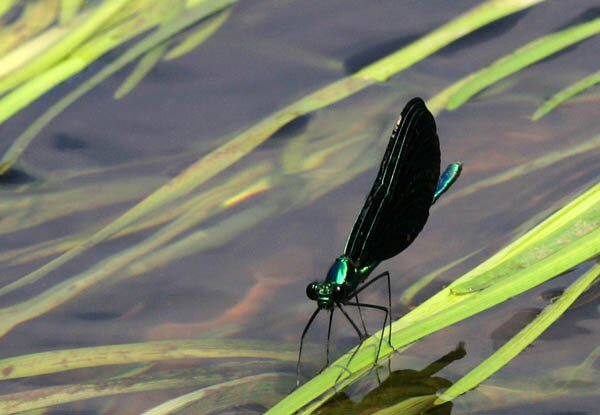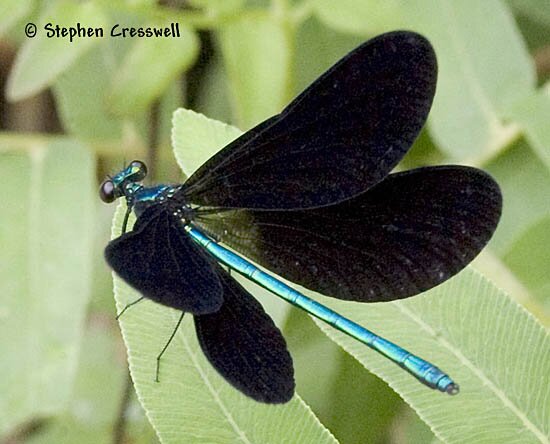

Family: Calopterygidae
Length: 39-57 mm
Ebony Jewelwing is among the more common damselflies in West Virginia, and certainly it is the most-noticed one. As the sunlight hits this damselflys body, the color is a beautiful metallic green. As the angle of the light changes the color may seem to shift to a teal blue. As the angle of light changes still further, and as the quantity of light decreases, the Ebony Jewelwings body may seem to be black.
Like its several relatives in the Broad-winged Damselfly family, Ebony Jewelwings like to live alongside clear flowing water. In the case of Ebony Jewelwing, the preference is for small to large creeks or small rivers, especially those flowing through forests. Unlike some of its relatives, however, the Ebony Jewelwing may leave the creekside behind and flutter off into nearby meadows.
 It is easy to tell this species from others. This is the only damselfly in West Virginia, or anywhere near West Virginia, that has all-black wings. Differentiating males from females is also easy with this species. The females have a small white pterostigma on each wing, while the males do not.
It is easy to tell this species from others. This is the only damselfly in West Virginia, or anywhere near West Virginia, that has all-black wings. Differentiating males from females is also easy with this species. The females have a small white pterostigma on each wing, while the males do not.
A favorite of many, this damselfly has been collected in most counties in West Virginia. Those counties that have no record of this species are probably counties where little, if any, collecting of Odonates has ever taken place. The species is probably present in all fifty-five counties.
Alcock (1983) described the courtship of Ebony Jewelwings. The male faces the perched female and whirs the wings "in a hovering courtship flight." The next stage of the courtship involves the male landing on the females' wings, "to bite and pull at her." Soon the female takes to the air, with the male in pursuit, and copulation follows.
Alcock reported that males seem to recognize their mates from earlier in the day, and typically do not complete a second courtship and copulation with them.
Johnson (1962) reported that copulation nearly always lasts about five minutes. Oviposition is more variable, occupying 10-30 minutes.
Researcher J.K. Waage got his 120 minutes of fame in a 1979 article in Science. Waage showed that the male Calopteryx maculata "uses its penis not only to transfer sperm to the female but also to remove sperm deposited in the females sperm storage organs from previous matings." Waages article provided the first proof of sperm displacement anywhere in the animal kingdom. Since then, such displacement has been shown for other Odonata and for many other groups.
 |
| Ebony may seem an odd name to give to a damselfly with such beautiful blue-green coloration. But in this pose, spreading its wings in preparation for flight, there is plenty of ebony coloration displayed. |

|
| Above: The faces of male and female Ebony Jewelwings are essentially the same. The presence of white pterostigmas on the wings identify this Ebony Jewelwing as a female. |


